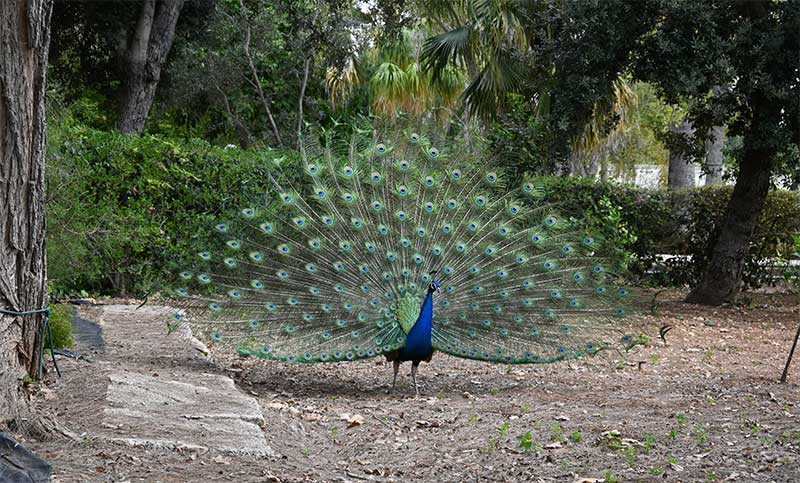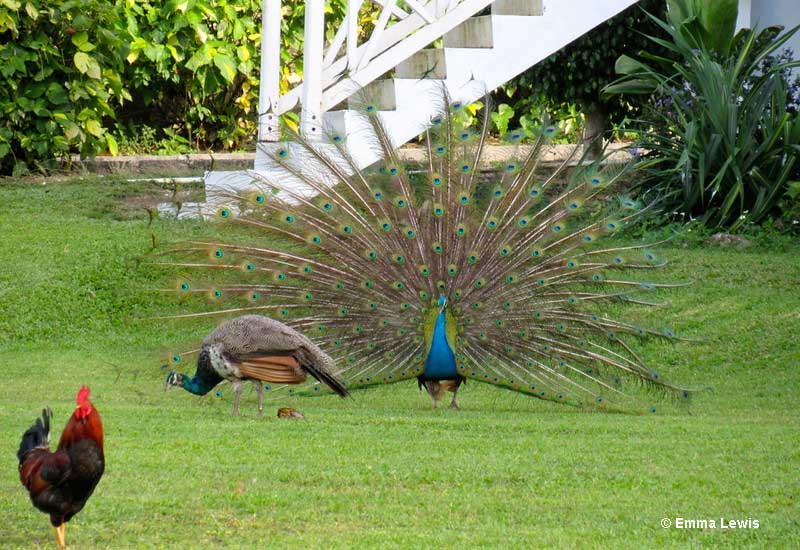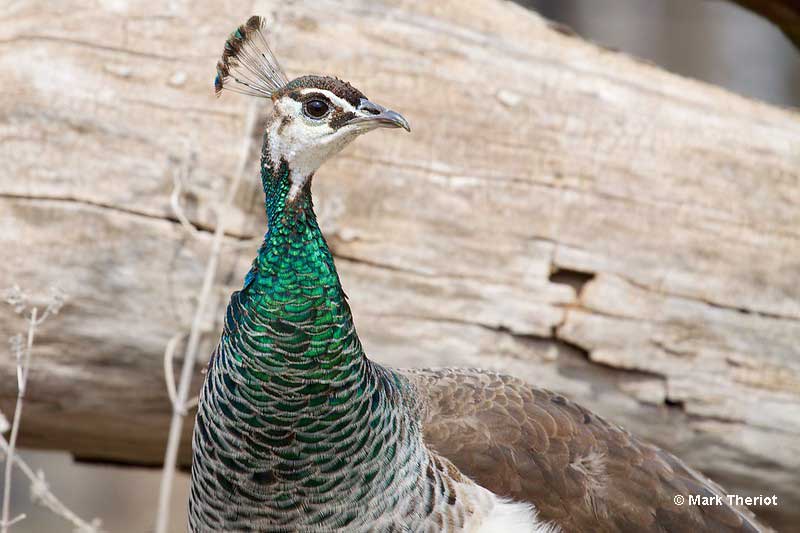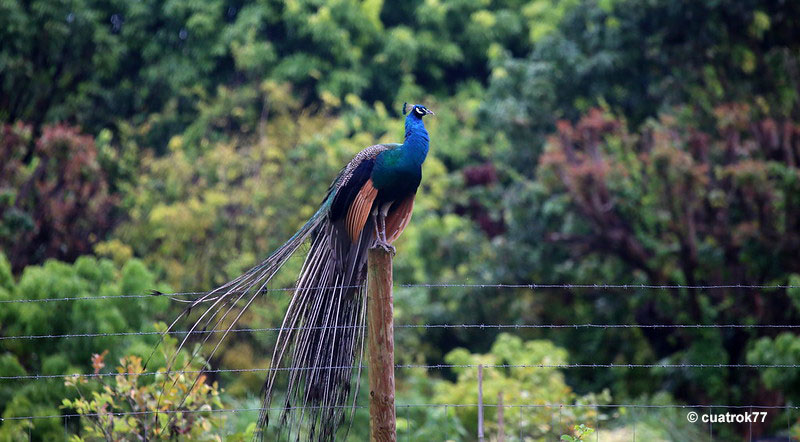
The true identity of the magnificent bird we commonly call ‘peacock’ is the Indian Peafowl. All peafowl belong to the landfowl family – stocky birds that prefer walking and running rather than flying.
But can peacocks fly? The misconception that these birds can’t fly comes from the fact that people often clipped the wings of the domesticated peafowl before we started considering it inhumane. Some prejudice also comes from the way they look – the elegant but large bodies, decorated with the males’ huge tail feathers.
But just how good flyers peacocks really are? Are there differences in flying skills between the extravagant males and the slender females? Read on to find out!
On this page
Can Peacocks Fly?
Peacocks – or peafowl, to be more precise – definitely can fly.
However, although peacocks are perfectly able to fly, it doesn’t mean these birds do it gladly or often. Observations tell us that they utilize flying only 2.6% of their time.
Why? Well, with a weight of up to 13 pounds (6 kg), peacocks are some of the heaviest flying birds in the world – who could blame them for preferring walking and running over flying?

Peacock and peahen flying usually come down to powerful, brief bursts that allow them to overcome physical obstacles, get to their food, roost in trees, change a foraging location, or, importantly, escape danger.
Related: What do peacocks symbolize?
The dangers are usually predators, including leopards, tigers, civets, feral dogs, or humans, that might mean no harm but can still startle them.
Do All Peacocks Fly?
All adult peacocks, including peacocks and peahens, naturally fly when needed. However, if you’ve ever witnessed a peafowl individual failing to take flight, even when in danger, here’s what it might be about.
- Age. Although they start practicing several days after hatching, peachicks will not be able to use their wings right after hatching, and it may take up to several months for them to learn to fly properly.
- Injury. Peacocks of all ages can suffer injuries to their wings that can prevent them from flying efficiently or at all.
- Wing clipping. Because peacocks are often kept as domestic, ornamental fowl, many owners and breeders want to prevent them from flying over fences and perching by performing wing clipping – cutting most of the flight feathers. The practice is inhumane as it prevents birds from displaying natural behaviors and escaping predators if any happen to enter the homestead.
How Far Can Peacocks Fly?
Peacocks are short-distance flyers that don’t cope well with flying for long. Data tends to differ, but they can only fly up to 100 meters (~320 feet) on average. They combine flying with jumping from high perches to cover a greater distance.
In this video, you can see how a typical male peacock looks in flight. Notice how the bird uses the high starting point to conserve energy by gliding rather than flapping constantly.
How High Can Peacocks Fly?
Peacocks aren’t very good at getting themselves off the ground and can’t do it as swiftly as many other birds. However, they can jump high – up to 6 feet from a standing position. Consequently, they can literally jumpstart their flight. They can reach about 8 feet (2.4 meters) by flapping their wings hard after the hop.

© Mark Theriot
The jump combined with short flight is how they get to their roosting spots at night. In the wild, a couple of hundreds of peacocks can fit into one large tree canopy!
However, even when trying to fly upward into the canopy, they actually fly as little as possible. Rather, they reach the first branch they can with the help of their wings and then use hopping to reach higher branches.
That is how, even with their modest flying abilities, they roost on heights between 7 and 22 meters.
Fun Facts About Peacocks
- Although we tend to use the term “peacock” for all members of the species, that is not actually the correct thing to do! The right term is ‘peafowl’. Male peafowl are ‘peacocks;’ females are called ‘peahens,’ while the juveniles are called ‘peachicks.’ Still, for easier understanding, we keep colloquially calling them ‘peacocks.’
- As you probably concluded, the tail with long and vividly colored tail feathers in (male) peacocks is called ‘the train.’ The peacock train serves only one purpose – for display to attract females. The displaying peacock will stand tall, spread its train while shaking it slightly, and flutter its wings. The decision about a perfect partner is always up to the female (the peahen). That is why peahens don’t have elaborate feathers like peacocks.
- Flight is not the only skill peacocks use to escape predation. In fact, they heavily rely on camouflage – especially the peachicks and peahens, which have drab colors in comparison to flashy peacocks.
- If you’ve ever wondered what peacocks do the entire day, one study tried to answer that. Indian scientists found that “Moving” was the most frequent behavior (38.10% of observation time), followed by feeding (27.93%) and resting (24%). Less frequent behaviors included preening (4.31%), flying (2.60%), vocalizing (2.52%), and displays (only 0.36%).
- The preferred habitat of peacocks is the scrub jungle. Researchers believe that this type of habitat provides great camouflage and concealment (and thus safety from predators) and is a rich food source.
Facts about peacocks’ relationship with humans
- Humans have kept domesticated peacocks for at least several hundred years, with some evidence suggesting they have been with us for as much as 2,000 years. In Europe, domesticated peacocks have been present since the 14th century but only owned by the aristocrats and the wealthy.
- Because they have been domesticated for so long, breeders had lots of time to develop various color forms of peafowl. There are 15 known colors, including blue, white, green, purple, bronze, peach, hazel, and indigo, five body patterns, and around 185 varieties that mix these features! So, if you see a weirdly colored peacock in captivity – yes, it is still an actual peacock.
- A group or a flock of peacocks is called a muster. At the end of the Medieval period and during the Renaissance, English aristocrats had a knack for imagining various funny and strange collective nouns for animals and other living groups – ‘peacock muster’ is one of them.
- Leopards and tigers might be fierce predators, but surprisingly, the biggest peacock foes are domestic dogs. Several studies successively found that village dogs and plantation dogs were top predators of peacocks.
Frequently Asked Questions
Can female peacocks fly?
Female peacocks (peahens) can definitely fly. In fact, being lighter of the two sexes and unbounded by that famous peacock train, they can probably fly better than the males. However, interestingly, scientific measurements have never proven peahen flying superiority, and the train (or the lack of it) doesn’t seem to make much of a difference in flight.
Can male peacocks fly?
Although it may surprise you due to their immense tail feathers – the train – peacocks fly nearly the same as females. Both sexes still prefer walking and running, but the peacock train isn’t a disadvantage in flight. The overall bulky build and mass of peacocks make them inefficient flyers, not the tails.
Can peacocks fly long distances?
No, peacocks are able to cover only short distances by flying. An average peacock can cover a distance of only 80-100 meters, but even flights that long (or short) are rarely observed.
Peafowl belong to the family of landfowl (Phasianidae), along with pheasants, grouses, and chickens. These birds have stocky bodies and are poor fliers but excellent runners. Thus, if they have a choice, peacocks would rather run for their lives than try to fly away – flying is used as a last resort.
What age can young peacocks fly from?
The peachicks (that baby peacock name is adorable, isn’t it?) are precocial – they hatch very well-developed and already resemble adults. Since their feathers continue developing at a fast pace after hatching as well, physically speaking, the chicks would be able to fly at only three days old.
However, juvenile peacocks still need additional time to properly learn to fly. They need a few weeks to fly decently, but it can take up to 6 months to fully master the flying skill.
How fast can peacocks fly?
At their fastest, peacocks can reach a flying speed of around 10 miles per hour. Their running speed is about the same. However, note that there are no extensive scientific measurements and comparisons of peacock flying speeds.

